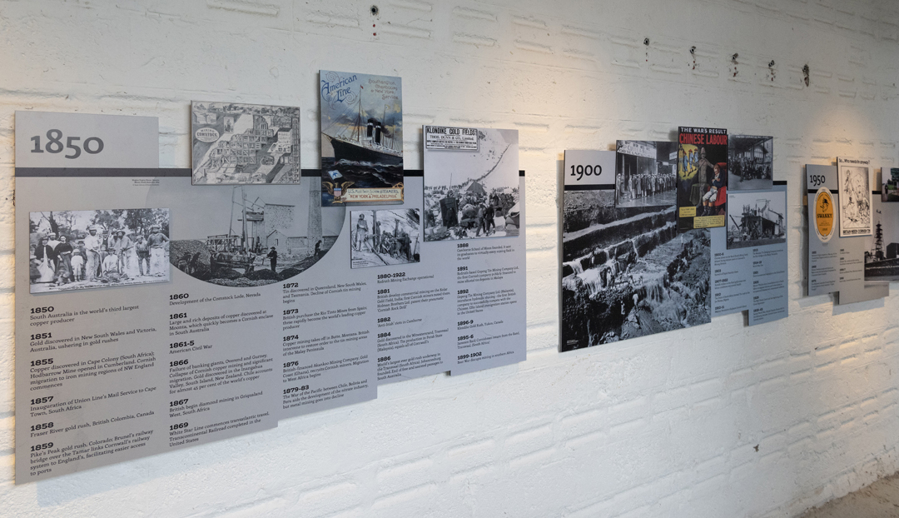Major Cornish mining migration exhibition opens at Heartlands
The Heartlands Trust has recently unveiled an exciting new exhibition at the Heartlands site which focuses on Cornish mining migration and progress towards the production of technology metals and renewable energy in Cornwall.
Heartlands, which was created around the Grade II* Listed building complex at Robinson’s Shaft, South Crofty Mine, is a Key Centre for the Cornwall and West Devon Mining Landscape World Heritage Site. As such, it presents aspects of the Cornish mining story and landscapes which are of international importance.
The exhibition, which is a new permanent feature of Heartlands, is the result of a significant Culture Recovery Grant awarded by the National Lottery Heritage Fund in 2020. The exhibition departs from previous displays in that it highlights the fascinating story of mining migration specifically, which is an important aspect of the social history of Camborne, Pool, and Redruth - also known as the Central Mining District.
Many thousands migrated from Cornwall in the nineteenth century to places as far afield as South America, Australia, India, North America and South Africa. The exhibition shines a spotlight on this and - for the first time - details the true scope of mining migration which saw an estimated 250,000 to 500,000 people leave Cornwall during the century from 1815 to 1915.
The new migration focus complements well the popular Heartlands’ Diaspora Gardens and has been created by historian Dr Sharron P Schwartz, who is the foremost authority on Cornish mining migration, and graphic designers Perch & Ponder Limited. It examines the places that the Cornish went to and looks at the profound and lasting effects migration had on individuals and their families, and the towns and villages they left behind. It is a story of true adventure into the unknown and celebrates the pioneering spirit of the Cornish.
Dr Schwartz, who was born and raised in Redruth, has skilfully woven stories of her own family into the exhibition narrative. Like many in the area, she has ancestors which took their much in demand mining skills all around the globe, including to South America and South Africa.
‘For years I have longed to see a dedicated exhibition devoted to a story that has indelibly shaped the people and settlements of the area I was born and bred in. Like countless other Cornish people from a mining background in Camborne-Redruth, migration has shaped the branches on both sides of my family tree.
‘There are many tales of trials and tribulations, tragedies and triumphs in my family, and one of these concerns Bill Harvey a brother to my great grandmother. In 1907, Bill was killed in an underground explosion in the Dreifontein Mine, South Africa, just weeks after his brother John had died of enteric fever in nearby Randfontein. Both had previously worked in the United States. Bill left four children and his widow expecting their fifth at Pennance, while John was survived by two children. After these tragedies, the brothers’ wives and their children returned to Michigan, causing yet more heartache as the family never saw them again.
‘Familial experiences and events like this have forged my Cornish identity and cultural heritage and eventually helped to shape my career. As a local girl with an authentic and in-depth knowledge of this truly remarkable period in Cornish history, I was delighted to have been engaged as the consultant to devise and produce the historical content for a 12 minute documentary film and the new exhibition. The displays also include many never-before-seen historic photographs and utilises the most up-to-date maps ever produced to illustrate the global spread of Cornish mining migration. It is entirely fitting that this major new exhibition is sited at Heartlands, the very heart of Cornish mining, engineering and migration.’
Dr Schwartz has also recently launched a new website which explores the migration of Cornish mineworkers and their culture. Currently in development, ‘Cousin Jacks World’ promises to be an essential source of information and includes a piece on her recent work with Heartlands: https://www.cousinjacksworld.com/
The exhibition space also now includes a step into the future and looks at those companies currently pursuing the resurgence of Cornish mining and sustainable energy sources. Being a collaborative effort with local industries, this aspect of the exhibition is aimed at providing the public with up-to-date information on current progress and the potential to pursue careers in engineering.
The official opening of the exhibition was performed by Karen Maddocks, H.M. Ambassador to Montenegro, on Friday 9 July. Born and raised in St. Austell, Karen was educated at Poltair School and is an inspiring example to all young people locally.
The new exhibition places the efforts of the Cornish very much at the centre of the Heartlands’ story and is sure to be well received by all those that wish to learn more of the incredible global reach of their ancestors.




